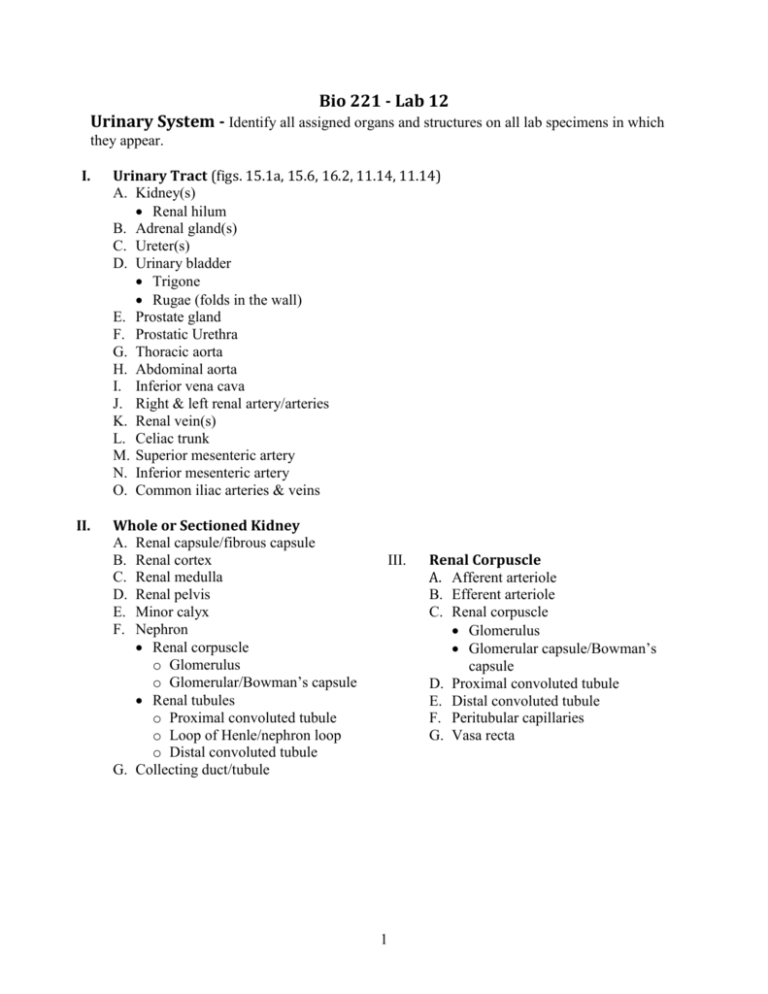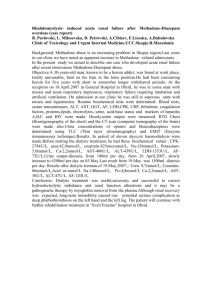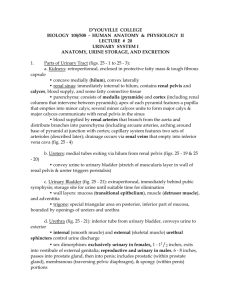Urinary & Reproductive
advertisement

Bio 221 - Lab 12 Urinary System - Identify all assigned organs and structures on all lab specimens in which they appear. I. II. Urinary Tract (figs. 15.1a, 15.6, 16.2, 11.14, 11.14) A. Kidney(s) Renal hilum B. Adrenal gland(s) C. Ureter(s) D. Urinary bladder Trigone Rugae (folds in the wall) E. Prostate gland F. Prostatic Urethra G. Thoracic aorta H. Abdominal aorta I. Inferior vena cava J. Right & left renal artery/arteries K. Renal vein(s) L. Celiac trunk M. Superior mesenteric artery N. Inferior mesenteric artery O. Common iliac arteries & veins Whole or Sectioned Kidney A. Renal capsule/fibrous capsule B. Renal cortex C. Renal medulla D. Renal pelvis E. Minor calyx F. Nephron Renal corpuscle o Glomerulus o Glomerular/Bowman’s capsule Renal tubules o Proximal convoluted tubule o Loop of Henle/nephron loop o Distal convoluted tubule G. Collecting duct/tubule III. 1 Renal Corpuscle A. Afferent arteriole B. Efferent arteriole C. Renal corpuscle Glomerulus Glomerular capsule/Bowman’s capsule D. Proximal convoluted tubule E. Distal convoluted tubule F. Peritubular capillaries G. Vasa recta Lab 12 Urinalysis Examination of the urine is a common clinical procedure. None of the tests are difficult, but all may yield results that are of considerable diagnostic importance. The purpose of this exercise is to demonstrate some of the more common tests. Obtain materials and execute just one test at a time to avoid contaminating reagent tablets, etc. Each student will complete all of the tests on a sample of their own urine. Approximately 100 ml of urine is adequate. 1. Albuminuria This test looks for the presence of a common plasma protein, albumin, in the urine. Reagent strips commercially called “Albustix” are employed. Obtain a reagent strip but do not touch the colored end of it; dip the colored end into the urine specimen, them compare the dipped end with the color scale on the bottle. Record your result in the number of milligrams of albumen. Normally, there is little or no albumen in the urine. Small amounts are regarded as normal; stress and other factors can influence this value. 2. pH Using a strip of pH paper, dip the colored end into your urine sample. Compare the dipped end with the color scale on the package. Urine pH is generally slightly acidic, but may vary from 4.8 to 8.0 under different circumstances. 3. Glucose The test for glucose will be performed using reagent strips called “Clinistix.” Repeat the procedure for #1 above. Normally the urine should contain no glucose; the presence of glucose in the urine is most commonly due to diabetes mellitus. 4. Occult Blood (Occult hematuria) Occult blood is simply that which is present in such minute quantities that it can be detected only by chemical means. We will use “Hemastix” to test for blood in our urine. Follow the procedures for #1 above. Normally no blood is found in the urine in males; it may be found during menstruation in females. 2 5. Ketonuria This is a test for ketones in the urine. We will use “Ketostix” for this test. Follow the procedures for #1 above. Normally no acetone is found in the urine; the presence of them are often seen during starvation, or in diabetes mellitus. 6. Bilirubinuria Obtain an ictotest tablet, and mat. Put 5 drops of urine on the mat, place the tablet on top of it and add 1 drop of water. After 5 seconds, add a second drop of water. If the drops remain on the tablet, add another drop of water. The test is positive when the mat around the tablet turns bluish purple (ignore tablet color). The amount of bilirubin is proportional to color and time of reaction. Negative test is when mat shows no color or is only pink or red. Normally bile acids and bilirubin are not found in the urine. Urinalysis Report Sheet Some of the urine-related disorders are discussed in your text. For the others, you will need to refer to a book on clinical diagnosis or a medical physiology text; the Merck Manual may also be helpful. Results: Color & Clarity: ______________ pH: ____________ 3 Negative Trace + ++ +++ see Doctor Albumin Glucose Occult Blood Ketones Bilirubin Questions: 1. What is the normal range of urine output, daily, for a healthy adult? 2. What conditions may be indicated by “cloudy” urine? Is this a normal finding? Why or why not? 3. The pH of urine normally ranges from what to what? What does a decrease in urine pH mean? An increase? 4. Discuss what an abnormal reading in the tests you performed today would indicate physiologically. Consider things such as filtration, reabsorption, damage to kidneys, or malfunction of other organs. a. b. c. d. e. f. Albuminuria pH Glucose Occult Blood (Occult hematuria) Ketonuria Bilirubinuria 4 Bio 221 - Lab 12 Reproductive System Identify all assigned organs and structures on all lab specimens in which they appear. I. Male Pelvis – sectional view A. Testis/testes B. Epididymis C. Scrotum D. Vas deferens/ductus deferens E. Pubic symphysis (if midsagital)/pubis (if parasagittal) F. Urinary bladder G. Ejaculatory duct H. Seminal vesicle(s) I. Prostate gland J. Urogenital diaphragm K. Bulbourethral/Cowper’s gland(s) L. Prostatic urethra M. Membranous urethra N. Penile/spongy urethra O. Corpus spongiosum (surrounds penile urethra) P. Corpus cavernosum/corpora cavernosa (paired, lateral erectile bodies) Q. Penis Shaft Glans Prepuce/foreskin R. Sigmoid colon S. Rectum T. Anus II. Male Pelvis – intact view A. Testis/testes B. Epididymis C. Scrotum D. Vas deferens/ductus deferens E. Pubic bone/pubis F. Urinary bladder G. Seminal vesicle(s) H. Ejaculatory duct I. Prostate gland J. Penis Shaft Glans penis K. Prepuce/foreskin 5 III. Female Pelvis – sectional view A. Uterus Cervix Endometrium Myometrium Perimetrium B. Ovarian ligament C. Round ligament D. Broad ligament E. Fallopian tubes/Uterine tubes F. Ovary/ovaries G. Vagina H. Clitoris I. Labia majora/majus/major J. Labia minora/minus/minor K. Mons pubis L. Pubic symphysis M. Urinary bladder N. Urethra O. Sigmoid colon P. Rectum Q. Anus IV. Female pelvic organs - intact A. Uterus Fundus Body Round ligament(s) B. Ovary/ovaries Ovarian ligament(s) C. Fallopian tube(s)/Uterine tube(s) Isthmus Ampulla Infundibulum Fimbria(e) D. Urinary bladder V. Ovary (secondary & mature vesicular follicles are poorly depicted on our model) A. Primordial follicle(s) B. Ovulating follicle C. Ruptured follicle D. Corpus luteum E. Corpus albicans F. Germinal epithelium 6 VI. Breast A. Skin B. Areola C. Nipple Opening of lactiferous duct D. Lactiferous duct Lactiferous sinus/ampulla E. Lobe of mammary/alveolar gland F. Adipose connective tissue G. Pectoralis major muscle H. Rib(s) I. Intercostal muscle(s) 7








